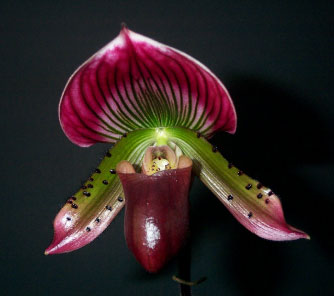DENDROBIUM & ONCIDIUM
|
| |
| Dendrobiums come from South East Asia in an area that stretches from Northern India to the islands off the East coast of New Guinea and Australia to Polynesia. The latitude where they grow is important. The Equator runs through the middle of this territory and here it is always hot at sea level without any seasonal variation .(They are Epiphytes) dendrobiums have clusters of smaller, long-lasting flowers on long stalks in spring or summer. They need a dormant period in the fall and winter, with little water but direct sun, until new flower buds form. In spring and summer they need a moist growing medium and good drainage. Light & Water These dendrobiums enjoy full morning sun, but will require shading between 11am and 3pm - less shading will be needed in late afternoon. An overhead light source is most effective. Phalaenopsis-type dendrobiums grow best when their potting medium becomes dry between waterings. They are epiphytes in Nature, (i.e. - they grow on trees) and are accustomed to becoming fairly dry between the rains of their natural habitat. Some types may require a time of drought to initiate flowering. Temperature & Humidity The ideal day temperature is 75-85 °F, (24-30 Celsius),while the ideal night temperature is 60-65 °F. 16-18 Clsius),Occasional temperature extremes are tolerated if exposure is not prolonged. Dendrobium enjoy moist air, requiring a minimum of 40-50% humidity in the immediate vicinity of the plant. Humidity should be increased with higher temperatures. The ideal humidity is between 55 and 75%, with as much ventilation or air movement as possible without any cold drafts. Humidity can be increased around the plant by placing the pot on an inverted saucer in a baking pan filled with pebbles, rock chips, etc., and water. Keep water level below top of pebbles so that the plant will not have "wet feet" from setting in water. Morning misting of foliage is also helpful, especially during periods of hot weather. Potting & Feeding Repot once every two years in Spring, after blooming, or when new growth starts A mix of 10 parts fine-grade Fir-bark and 1 part orchid mix will work well in 6" pots and smaller, while medium-grade Fir-bark works well in larger pots. High-nitrogen fertilizers can be used year round. Feed "Weekly Weakly" (at 1/4 strength once a week). Fertilize: regularly while plants are actively growing. Applications of 30-10-10 formulations twice a month are ideal for plants in a bark-based potting medium. A 20-20-20 formulation should be used on plants in other media or on slabs. If skies are cloudy, applications once a month are sufficient. | Are a very large genus which grow naturally throughout the tropical zones of the American Continent and Caribbean
Light & Water Most Oncidium and their hybrids prefer filtered, subdued light (from 1000 to 1500 ft. candles). The Oncidiums prefer bright light.The leaves should be bright green as opposed to dark green or reddish green. Reddish green indicates too much light; dark green indicates not enough light. Oncidiums should become moderately dry between waterings. Generally, they require more water while the new shoot is growing and less once the bulb has formed. Feed "Weekly Weakly" (at 1/4 strength once a week). Take care to keep water out of the new growth at the base of the plant. Never allow the bottom of the pot to stand in water. Never use artificially softened water. Temperature & Humidity Most Oncidiums and their hybrids enjoy intermediate temperature ranges:75-85 F,(24-30 C). day & 60-65 F(16-18 C). at night Oncidiums enjoy moist air, requiring a minimum of 40-50% humidity in the immediate vicinity of the plant. Humidity should be increased with higher temperatures. The ideal humidity is between 55 and 75%, with as much ventilation or air movement as possible without any cold drafts. Humidity can be increased around the plant by placing the pot on an inverted saucer in a baking pan filled with pebbles, rock chips, etc., and water. Keep water level below top of pebbles so that the plant will not have "wet feet" from setting in water. Morning misting of foliage is also helpful, especially during periods of hot weather. Potting & Feeding Repot Oncidiums at least every two years. As a general rule, repot them when the new shoot is two to three inches tall or when new roots appear. All the old mix should be removed from the roots and any dead roots should be removed. If dividing, keep the divisions in clumps of three to five mature bulbs. Do not repot Oncidiums unless the new growth has come out of the pots or the medium has decomposed. Remove individual flowers as they fade. If lower leaves turn yellow,they can be removed without damaging the plants. Medium to fine fir bark is preferred. The base of the new growth should be potted about 1/2" (no deeper) into the fresh bark. Keep mix barely damp until you see the new roots penetrating the bark, then resume normal watering. High-nitrogen fertilizers can be used year round. Feed "Weekly Weakly" (at 1/4 strength once a week). Fertilize: regularly while plants are actively growing. Applications of 30-10-10 formulations twice a month are ideal for plants in a bark-based potting medium. A 20-20-20 formulation should be used on plants in other media or on slabs. If skies are cloudy, applications once a month are sufficient. Copyright : http://www.orchid4u.com/55560/DENDROBIUM----- |





Đăng nhận xét